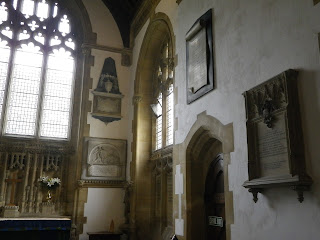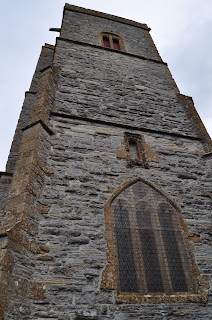Morning
broke in Hilperton more or less as the previous day ended – dreary and cool and
wet.
 |
| The Lion and Fiddle Free House - Hilperton |
We
packed up the bags and rumbled downstairs to check out of the Lion and Fiddle. The owner was wiping
down the bar; his wife was tidying up the lounge. We greeted the 60-ish
gentleman, whose name we unfortunately never thought to ask, thanked him for a
nice dinner and very nice accommodations (he apologized for the wedding noise
and attendant commotion, but there was no need, it was nowhere near a bother
for us). The guy had spent many years working and living in the States –
Tennessee, among other places – in some capacity in the civil construction
trade, and returned to Hilperton a few years ago to run this little free house.
I asked
about that term. “Free house”.
A free
house is a tavern that is unaffiliated with a particular brewery. In England,
and the details of this I’m probably going to get a little wrong, most pubs
(“public houses”) are essentially an extension of a single brewery – they serve
only their beer product from the tap, or beers approved by the brewery owners -
while a “free house” is typically owned by an individual who serves his patrons
whatever he likes. I got the impression that a “free house” was a distinction
of some merit, and that these things had their roots deep in English history
and tradition. It also occurred to me that the great brewpub culture still
expanding in the US is rendering the beer topography curiously like England’s,
with local breweries opening their own restaurants and serving their own beer,
to the exclusion of malt beverages brewed by craft beer competitors, or even
the mega-breweries like Miller-Coors or Anheuser Busch. Try ordering a Bud
Light in your average brewpub.
Anyway –
it was a conversation piece I lofted as we were finishing up the paperwork, but
the gentleman certainly didn't need any coaxing for conversation, reeling off stories
of Hilperton, famous and long-dead English railroad engineers, driving in the States
vs driving in England, the fickle fortunes of getting a share of the Bath
tourist trade, etc etc, all with a heavy accent (I don’t know, was it a
southern Midlands accent?) that at times left me nodding and “uh-huh’ing” in
unconvincing befuddlement.
I looked at my watch several times, feeling
uncomfortable about impolitely cutting the guy off but mindful of a fairly
ambitious day ahead of us. The place didn't get a lot of US tourists (“last
ones were, oh, a month or so ago,” he half-remembered), and I guess chatting up
some Yanks was a rare enough event for the proprietor to savor.
We
finally extracted ourselves from the bar, wrestled the luggage into the VW…and
then of course, I had to find a loo (again) before we took off, so with some
goodbye-hello-again awkwardness, I went back inside. The owner was gone, but
his wife was puttering about, I asked her where the men’s room was and she
pointed me down a hallway, and of course I couldn't find the magic door, so I
went back up the hallway and apologized, and she re-pointed back the hallway
with her free hand while vacuuming the lounge carpet, and I went down there
again, spotted a door I would swear wasn't there 15 seconds earlier, and
comforted my aging and prostate-cramped bladder. I hate long goodbyes.
Back on
the road.
Lacock is a curious place.
 |
| High Street, Lacock |
 |
| Sharon in Lacock |
And it’s
probably a mild disservice to refer to the place as a “second tier” tourist
destination, as after we parked and walked toward the town, we strolled past at
least 16 shiny tourist buses all lined up in specially designed parking
spaces, their blue-haired and gawking patrons presumably wandering the streets.
The buses were everywhere, at least on the outskirts of the village proper;
 |
| Tour buses on High Street- Lacock |
off the main drag, the streets were ridiculously narrow.
 |
| Back street - Lacock |
 |
| Back street - Lacock |
Lacock,
though, isn't really a museum. People actually live here – people with jobs and
cars and kids in school and shopping needs and everything else – so the village
exudes this weird, two-tiered kind of vibe; locals going on with their business,
overlaid with a steady stream of camera-snapping tourists shooting pictures of
their houses and streets and corner shops and front doors.
Living in a tourist town probably
isn’t as big a deal as all that – you can get used to anything – but maybe
because of its small size, Lacock just seemed to highlight the dichotomy more
to me than, say, York. It did occur to me that homeowners in Lacock are likely
to feel strict constraints on them by the National Trust regarding building
facades and property improvements that owners of historic properties in my own
town (Boulder) must endure as well, so there’s probably a good deal more to
actually living here than merely dodging the tourist buses. (But then again,
if the village is “owned” by the National Trust, does that mean its residents
are all renters?)
I
stepped funny off a curb at one point, falling to a knee in the street, tearing
my pants and scraping the skin on my kneecap. It actually hurt like hell; I
spent about half my time in Lacock limping a little.
We strolled
over to the municipal cemetery, a trim if unremarkable late Victorian memorial park.
A sign indicated that the cemetery was maintained by local
“offenders” through a program called Community Payback; we know this here as
community service, commonly assigned to defendants guilty of misdemeanor
criminal offenses...
...although I'm unaware if community service troops stateside are commonly thanked for their work.
The cemetery backs up to a sizable farm, and we heard the
owner slapping and swearing at his animals unseen over the fence. An odd
moment.
Next was
St Cyriac’s, first dedicated in the 11th century but largely rebuilt
in the fifteen and sixteenth centuries and the village’s medieval church.
Inside,
the Church was a somber affair, predictably elegant with its carved monuments
and medieval trimmings,
 |
| St Cyriac Church - Lacock |
 |
| St Cyriac Church - Lacock |
 |
| St Cyriac Church - Lacock |
 |
| St Cyriac Church - Lacock |
 |
| St Cyriac churchyard |
 |
| St Cyriac churchyard |
 |
| St Cyriac churchyard |
Back on
the road, headed toward the ancient Avebury, but we had saved off another
church on the GPS – St Anne’s, just outside the village of Bowden Hill – so we
made a minor detour and headed over. Odd church, this one was. Clearly
Victorian, with inexplicable and almost mysterious trimmings, the church sat on
a gentle hillside overlooking the Wiltshire Plain and hosted a smallish,
barely-century-old churchyard.
The place had the faint scent of country-home
wealth, a tidy place of worship for gentleman farmers. A nice lady was tending
to one of the graves and greeted us with a smile…but the church itself was
locked.




































